
A pictorial reconstruction of Confuciusornis (above)
Confuciusornis
Period: Mesozoic Age, Cretaceous
Age: 120 million years
Location: China
The theory of evolution claims that birds evolved from small theropod dinosaurs-in other words, from reptiles. The fact is, however, that anatomical comparisons between birds and reptiles refute this claim, as does the fossil record. The fossil pictured belongs to an extinct species of bird known as Confuciusornis, the first specimen of which was discovered in China in 1995. Confuciusornis bears a close resemblance to present-day birds and has demolished the scenario of avian evolution.
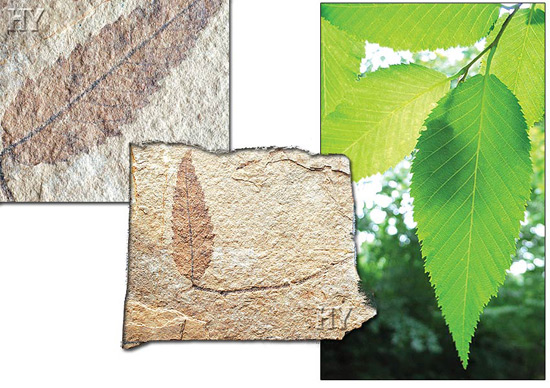
A present-day specimen of hornbeam leaf
Period: Eocene
Age: 54-37 million years
Location: Cache Creek Formation, British Columbia, Canada
Hornbeams of some 30 to 40 different species occur across much of the North Temperate regions, with the greatest number of species in East Asia, particularly China. A few species occur in Europe and North America. Fossil findings reveal that hornbeams alive today and those that lived tens of millions of years ago were no different. Hornbeams challenge Darwinist claims and proclaim Creation as an obvious fact..
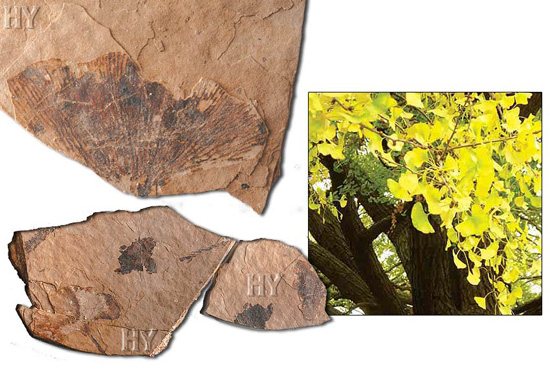
A present-day ginkgo leaf
Ginkgo Leaf
Period: Eocene
Age: 54-37 million years
Location: Cache Creek Formation, British Columbia, Canada
One piece of evidence invalidating the scenario of plants' evolution is the ginkgo leaf pictured, which is approximately 50 million years old. This fossil shows that ginkgos have not originated from another plant or transformed into another species. This places evolutionists in a deadlock..
www.evolutiondeceit.com

The illustrations below show present-day cones no different from the fossil specimen.
Pine Cone
Period: Cenozoic era, Paleogene subperiod
Age: 65-23 million years
Location: Germany
The structure of cones, organs on conifers that contain the plant's ovaries, has remained the same for millions of years, as with the structures of all other living species. This cone, 65 to 23 million years old, and identical ones of our day are one of the important examples revealing that throughout these long ages, evolution has never occurred.
www.theprophetmuhammad.org
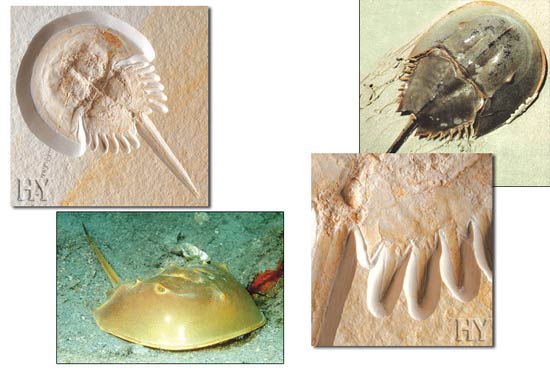
Below: Presentday specimens
Period: Mesozoic era, Jurassic period
Age: 150 million years
Location: Solnhofen Limestone, Germany
Horseshoe crabs belong to a subphylum of the arachnids called Chelicerata, and are more closely related to spiders and scorpions. The 150-million-year-old fossil of a horseshoe crab shown here demonstrates once again that Creation is a fact and that the process of evolution never occurred.
www.living-fossils.com
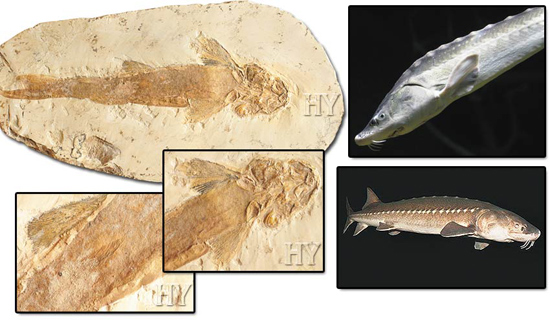
There is no difference between the sturgeon in the picture to the side and the 144-million-year-old fossil sturgeon above.
Sturgeon
Period: Mesozoic era, Jurassic period
Age: 144-65 million years
Location: China
The sturgeons, of which only two families remain in existence, have always been sturgeons. They have neither developed from, nor turned into any other species. Fossil finds corroborate the fact that like all other creatures, sturgeons have never undergone any process of evolution.
www.riseofislam.com
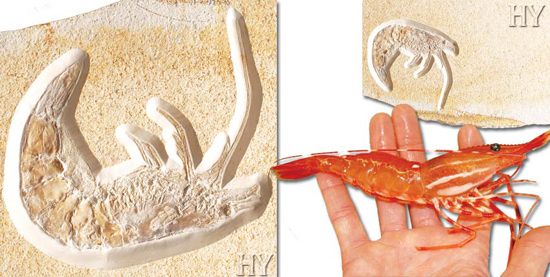
One of the fossils that demonstrate the clear fact of Creation is shown here: the nearly 150-million-year-old remains of a shrimp, which is no different from its present-day counterparts.
Shrimp
Period: Mesozoic era, Jurassic period
Age: 150 million years
Location: Solnhofen Limestone, Germany
Another scientific discovery showing that there was no process of evolution, as the Darwinists claim, is the fossilized shrimp illustrated here. Since shrimp first came into existence, they have always displayed all the same organs and characteristics as they have today and have undergone no changes in all that time. This shrimp fossil shows plainly that evolution is an imaginary scenario.
www.darwinism-watch.com
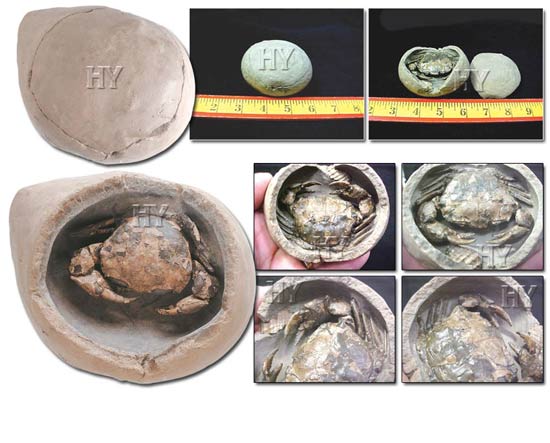
Right: Presentday crabs
Period: Oligocene
Age: 37-23 million years
Location: Denmark
The fossil record is sufficiently rich to account for the origin of life, and it reveals a concrete picture: Different species all emerged independently of one another, suddenly, and with all their different structures. No imaginary evolutionary "intermediate forms" existed among them. This is one of the proofs that Almighty Allah (swt) created all living creatures.
www.fossil-museum.com
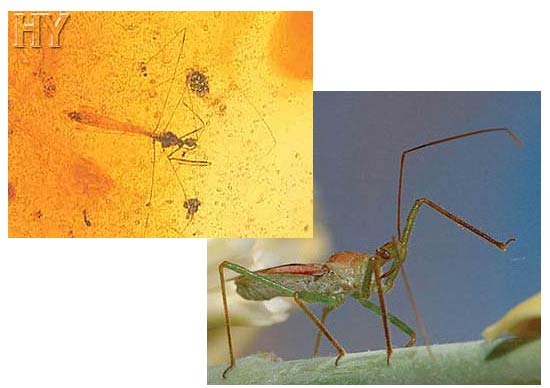
Right: An assassin bug living today.
Assassin Bug
Period: Cenozoic era, Oligocene - Miocene epochs
Age: 25 million years
Location: Dominican Republic
Assassin bugs are predatory insects of the Reduviidea family. Some of the species are able to transmit to humans a fatal malady known as Chagas' disease. It is this very insect that poisoned Darwin and caused him to spend the rest of his life in pain. This species uses its antenna to inject its poison and liquefies its victim's tissues.
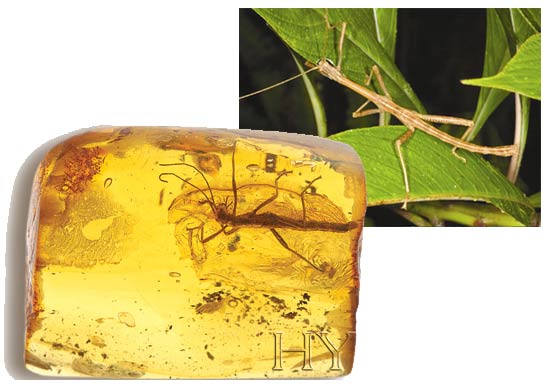
To the side can be seen a present-day stick insect.
Stick Insect
Period: Eocene
Age: 45 million years
Location: Russia
The stick insects are known for their ponderously slow movements and superb camouflage. With their long bodies, antennae and colors, they do indeed resemble slender twigs. Animals that use various forms of camouflage enjoy special protection with their bodily structures, shapes, colors and patterns, all created to match the environments they inhabit.
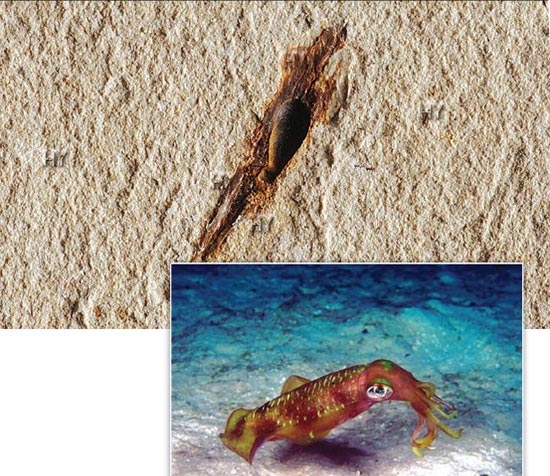
Squid
Period: Cretaceous
Age: 95 million years
Location: Lebanon
Darwin knew that his theory could be verified only by the fossil record, for which reason he pinned great hopes on paleontological research. Yet no intermediate-form fossil has been found over the 150 or so years since Darwin’s day. So his claims have never been confirmed. Fossils have buried Darwin’s theory of evolution, whose invalidity is now a proven fact. One such fossil is this 95-millionyear- old fossil squid, identical to living present-day specimens. www.evolutiondocumentary.com

Seen from beneath with its perfect details the fossil turtle (top right) is no different from present-day turtles (top left).
Turtle
Period: Oligocene
Age:37-23 million years
Location: Brule Formation, Nebraska, USA
The 37- to 23-million-year-old fossil turtle seen here is no different from turtles alive now, in all its perfect detail. Faced with these proofs, there's one important fact that evolutionists ought to accept. David B. Kitts, an evolutionist in the department of Geology and Geophysics at Oklahoma University, says that "Evolution requires intermediate forms between species and paleontology does not provide them." (David B. Kitts, "Paleontology and Evolutionary Theory," Evolution, Vol. 28, September 1974, p. 467)
www.thestoneage.org